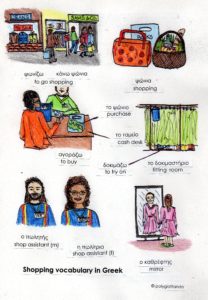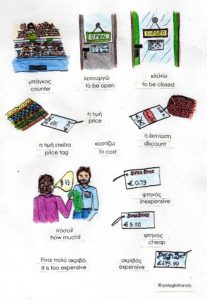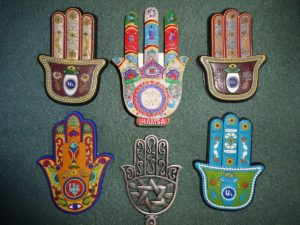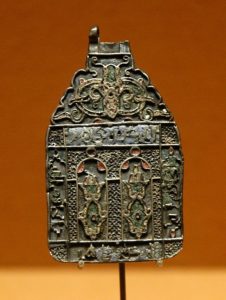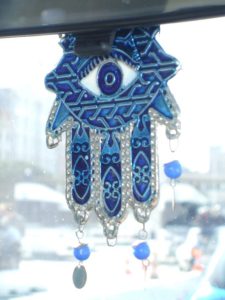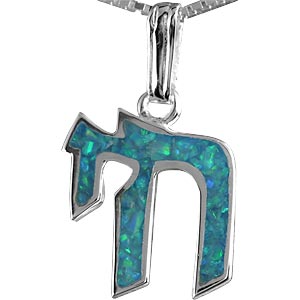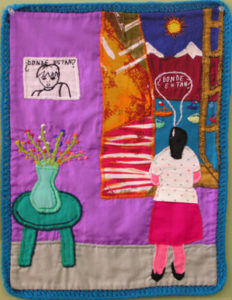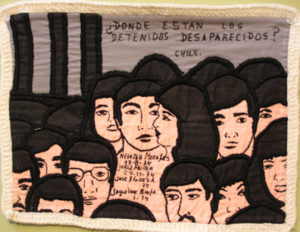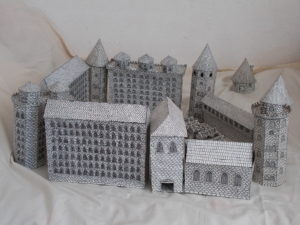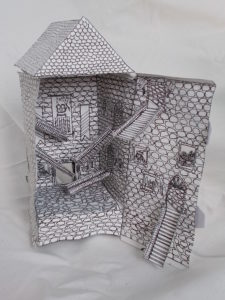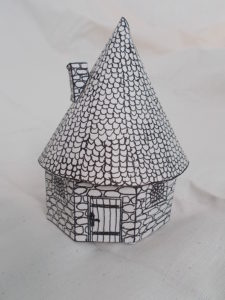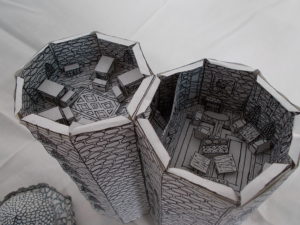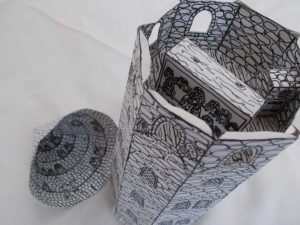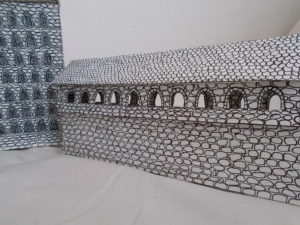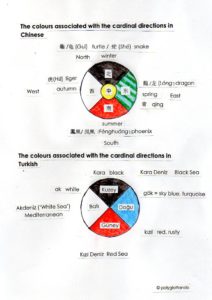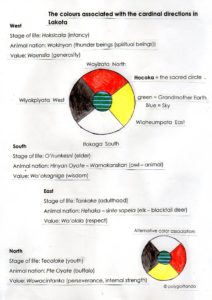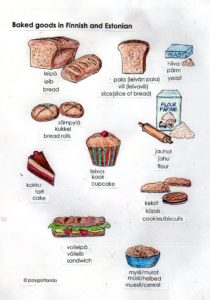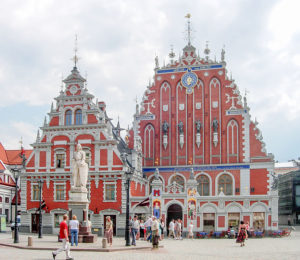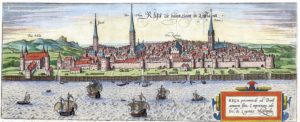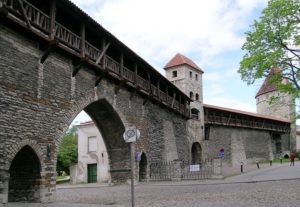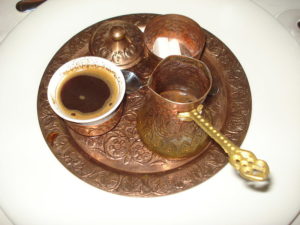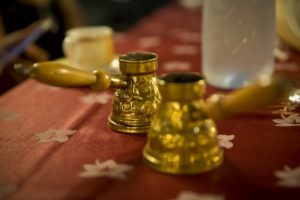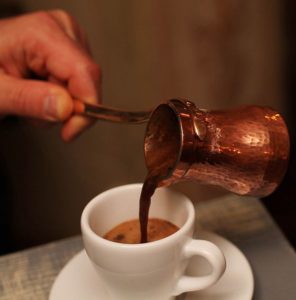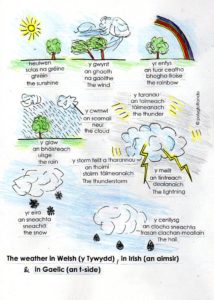Today’s blog post will take us to South Eastern Europe, namely to Greece, and to some vocabulary around the theme of shopping.
Category Archives: polyglot
Focus on culture: The Khamsa amulet (or Hand of Fatima)
Today’s blog post will take us to Israel and the Near East as well as to North Africa and to an ancient symbol of good luck and an amulet to ward off the Evil Eye, namely the Hamsa or Khamsa, which is also known as the Hand of Fatima or the Hand of Miryam. The Hamsa is a symbol of good luck in the Muslim and Jewish, but also Christian culture of the region.
The name hamsa (חַמְסָה ) comes from the Arabic word khamsa خمسة and from the Hebrew word hamesh חמש , both meaning ‘five’. In Berber, the Khamsa is called ⵜⴰⴼⵓⵙⵜ Tafust. In a Jewish context, the five fingers of the talisman refer to the five books of the Torah (Genesis, Exodus, Leviticus, Numbers, Deuteronomy) and the Jewish Hamsa is also called the Hand of Miriam, who was Moses’ sister. In a Muslim context, the hamsa is also called the Hand of Fatima, who was one of the Prophet Mohammed’s daughters, and the five fingers refer to the Five Pillars of Islam (faith, fasting, prayer, tax and pilgrimage). The number five itself is also associated with fighting the Evil Eye. In the Levantine Christian community, the Khamsa is also called Hand of the Virgin Mary (Kef Miryam in Arabic).
The Khamsa usually takes the form of an open hand with three extended middle fingers and a thumb and pinky finger on either side, which are always symmetrical and are either curved outwards or just significantly shorter than the middle fingers. The fingers can be either closed together to bring good luck as a talisman, or alternatively the fingers can be spread apart to act as an amulet to ward off evil. Usually, the image of an eye is embedded in the palm. It represents the all-seeing eye and is said to watch out for the owner and to protect them from the Evil Eye, or ayin hara (עין הרע). Other symbols that frequently appear on the Khamsa are fish דָגִים dagim, which are said to be immune to the evil eye since they live underwater (according to a line in the Torah “the water covers the fish of the sea so the eye has no power over them (Berakhot 55b)”) and which are also symbols of good luck. Also the Star of David מָגֵן דָוִד Magen David, prayers for the traveller, the Shema שְׁמַע, the blessing over the house, the Hebrew word mazal or mazel מַזָל, meaning ‘luck’, and the colours red and blue, which reputedly repel the evil eye, are often featured on the talisman.
The Khamsa is an ancient symbol that probably predates Judaism and Islam, though its precise origin is not known. The symbol of the open hand first appears in Paleolithic cave art in Spain, France, Argentina, Algeria and Australia. Predecessors of the hand symbol can be found in various ancient cultures: The Phoenician goddess Tanit was symbolized by a woman raising her hands, and in Egyptian art, the human spirit ka is depicted by two arms whose two fingers are held in a horseshoe shape and which reach upward. The Etruscans decorated their tombs with paintings of hands with horns and some Jewish Levite graves had images of hands, representing a religious blessing, on their stone markers.
The Khamsa first appeared in Sephardic Jewish culture תרבות ספרדית , which flourished alongside Muslim culture. The symbol of the hand, and in particular of priestly hands, can also be found in kabbalistic manuscripts and amulets, where it doubles as the letter Shin, which is also the first letter of the divine name Shaddai. This association of the hand with the divine name was believed to create a bridge between the believer and G’d. However, amulets or kamiyot קמיעות , from the Hebrew word for ‘to bind’ , are seen as somewhat ambivalent in Judaism, because the Torah prohibits magic and divination, whereas the Talmud mentions them on several occasions and accepts them, and one law approves the wearing of an amulet on the Shabbat (Shabbat 53a, 61a).
In Islamic folklore, the Hand of Fatima as a symbol has its origins in a legend: when Fatima’s husband Ali brought home a new wife one day, Fatima, who had been cooking at that moment, dropped the ladle she was using and, lost in thought, continued stirring with her hand, hardly noticing that she was burning herself.
The Hamsa is intrinsically bound up with the concept of the Evil Eye or Ayin hara ( Hebrew ʿáyin hā-ráʿ (עַיִן הָרַע), Arabic ʿayn al-ḥasūd (عين الحسود eye of the envious)), or the belief that a malicious look can bring about evil, which most often manifests itself through jealousy, but receiving the evil eye can also lead to misfortune and injury. To ward off the evil eye, many Jews will say ‘bli ayin hara’ בלי עין הרע (‘without an evil eye’) or ‘keyn eina hara’ קיין עין־הרע (Yiddish: no evil eye) after making a compliment or saying something positive. Muslims will say ‘Masha’Allah’ ” (ما شاء الله) (“God has willed it.”) and also “Tabarakallah” (تبارك الله) (“Blessings of God”) instead. Some people also use the saying ‘khamsa fi ainek’ خمسة في عينيك (lit. ‘five in your eye’) together with the gesture of their raised right hand with the palm showing and the fingers held slight apart, or use the phrase ‘khamsa wa khamis’ خمسة والخميس (lit. ‘five and Thursday’), since Thursday, being the fifth day of the week, was traditionally considered to be a good day for magic rituals and for pilgrimages to the tombs of saints.
The evil eye is also discussed in the Talmud תַּלְמוּד and the Kabbalah קַבָּלָה , though it is not mentioned in the Torah תּוֹרָה.
Other methods to ward off the evil eye in Jewish culture, besides hanging up or wearing a Hamsa, include wearing a Chai (חי) around the neck, symbolizing life ( Hebrew Chaya חַיָה life) or wearing a red thread around the wrist.
Focus on art/foco en arte: Arpilleras from/de Chile (bilingual post/entrada bilingüe)
Scroll down for the English text!!
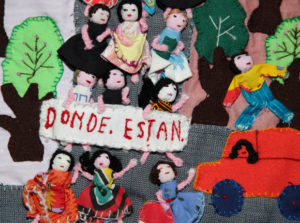
¿Dónde están?/Where are they? Anon. Chile, early 1980s
Photographer, Martin Melaugh (all images © Roberta Bacic), via http://www.latin-american.cam.ac.uk/events/arpilleras-dialogantes/arpillera-conversations
Esta semana, nuestro viaje nos lleva a Sudamérica, más precisamente a Chile, y a una forma distintiva de arte popular de este país – las arpilleras.
Arpilleras son tapices o imágenes textiles multicolores hechas con retales distintas que cuentan una historia y las experiencias de la vida cotidiana del pueblo. Son documentos históricos, mensajes de protesta y una forma del arte popular y del patriomonio al mismo tiempo. Tienen su origen en la dictatura militar de Augusto Pinochet Ugarte en Chile (1973-1990), durante la cual servían a documentar, a expresar y a denunciar la opresión y los crimenes del régimen porque todas otras formas de expresión libre normales eran prohibidas.
Las arpilleras chilenas fueron hechas por arpilleristas, grupas de mujeres cuyos maridos y/o hijos eran entre los víctimas del régimen, los así llamados ‘desaparecidos’ o ‘detenidos’. Fueron hechas en talleres organizados por una comisión de la Iglesia Católica chilena y entonces distribuídas en secreto al extranjero por la Vicaria de la Solidaridad, un grupo de derechos humanos de la iglesia católica de Santiago. El gobierno chileno consideraba las arpilleras traicioneras y prohibía su venta o exposición en el país, y por eso las primeras tapices fueron pasadas de contrabando al extranjero en bolsas diplomáticas. El régimen también confiscaba todos los paquetes, bolsas o maletas en los que sospecharon arpilleras. Por esta razón y para proteger a las mujeres, los tapices generalmente eran sin firmar. A menudo las ganancias de su venta en el entranjero eran los únicos ingresos de las arpilleristas porque a los parientes de detenidos o desaparecidos prohibieron hacer la mayoría de los trabajos.
Las raíces de las arpilleras datan de la época de los años 60 cuando una industria casera se desarrolló que producía bordados decorativos con escenas de la vida doméstica y rural con lana y hilos coloridos. Sin embargo, después del golpe militar en 1973, había escasez de lana y como consecuencia las arpilleristas empezaban a utilizar retales de paños por sus tapices. Las mujeres se reunían en pequeños talleres de un sólo cuarto en las afueras de Santiago cada semana para trabajar juntas. Cada taller tenía más o menos 20 miembros y a cada arpillerista se le permitió hacer sólo una arpillera cada semana, a menos que su necesidad de dinero era tan grande que el grupo decidió que podía hacer dos. El grupo también determinó el tema de las arpilleras cada semana. Cada arpillera era el trabajo de una mujer individual que desarrolló el diseño en el taller y luego lo cosió en casa.
Había algunas reglas respecto a los temas y a lo que podía ser mostrado en los tapices o no: por ejemplo, escenas de tortura u otros temas abiertamente políticos eran prohibidos, tanto como otras imágenes fuertes que puedan provocar el gobierno a detener a las mujeres. Solo eran permitidos eslóganes y palabras que también aparecían en la vida cotidiana, como sobre pancartas de manifestantes. Temas corrientes y comunes de las arpilleras son escenas de la vida rural y cotidiana, generalmente con los Andes en el fondo como testimonio e indicio de que las cuentas representadas tenían lugar en Chile, y casas, árboles y figuras humanas – generalmente tridimensionales con piezas como cabezas, brazos, etc. que resaltan de la superficie plana. Imágenes recurrentes incluyen ollas comunes (grandes calderos negros sobre un fuego) que la Iglesia chilena suministraba, los talleres de arpilleras mismos, las bombas de agua comunales y panaderías y lavanderías cooperativas que eran organizadas para ayudar a los pobres. Representaciones más políticas incluían grupos de manifestantes que llevaban pancartas y distribuían folletos políticos – ambos actos ilegales – , la policía militar con uniformes oscuros o puertas de fábricas y hospitales con una X sobre ellas, lo que significaba que eran cerradas a las familias de los desaparecidos o detenidos. Otros temas frecuentes eran niños que rebuscaban y coleccionaban cartones para venderlos, que lavaban coches o hacían cola delante de los hospitales o para recibir leche, o líneas eléctricas que la gente conectaba con las líneas eléctricas principales durante la noche para robar electricidad después de que el gobierno cerró su suministro de electricidad. Otros materiales, como por ejemplo frijoles secos, piezas de plástico, de papel, metal o de madera, fueron también cosidos o pegados a la superficie de las arpilleras.
Sin embargo, no todas las arpilleras mostraban escenas políticas y denunciantes: Algunas retratan una vida ‘idealizada’ como las mujeres la habrían deseado, con niños alegres, un paisaje pacífico, mercados florecientes y un buen Sistema de asistencia sanitaria, etc. – en breves palabras, retratos que expresaron el deseo y la esperanza de un futuro mejor. Por otro lado, había también talleres de arpilleras sancionados por el gobierno en los que mujeres fieles a la dictatura cosían tapices de propaganda, con temas alegres que retrataron a Chile como un país próspero con un gobierno benévolo. Con el tiempo, el arte de las arpilleras fue también adoptado por la gente en otros países latinoamericanos, especialmente en Perú, Nicaragua y Colombia, y sus tapices casi siempre retratan una vida feliz.
English text:
Today’s blog post is taking us to South America and Chile and to an art form that originated in this country, namely the Arpilleras, patchwork tapestries that were made by groups of women, the arpilleristas, during the military dictatorship of General Augusto Pinochet Ugarte (1973-1990) in Chile. The name arpillera derives from the Spanish word for ‘burlap’ (=arpillera), a type of sackcloth onto which the designs were sewn.
Arpilleras are small figurative patchwork tapestries made from scraps of fabric, which tell a story and the experiences of daily life of the makers and typically depict images of hardship, violence and of oppressive living conditions and human rights abuses during the regime. They are historical records, protest messages and a form of folk art and heritage at the same time. They have their origin in the military dictatorship of Augusto Pinochet Ugarte in Chile (1973-1990), during which all normal means of free speech and of free expression were prohibited and so they served as an outlet to document, denounce and express the oppression and crimes of the regime.
The Chilean arpilleras were made by the arpilleristas, groups of women whose husbands and sons were among the desaparecidos, literally ‘those who have disappeared’, and the detained. They were made in workshops organized by a commission of the Chilean Catholic Church and then distributed abroad in secret by the Vicaria de la Solidaridad, the Vicarate of Solidarity, a human rights group of the Catholic church of Santiago. The Chilean government considered the arpilleras as traitorous and prohibited their sale and exhibition in the country. Therefore, the first tapestries had to be smuggled out of the country in diplomatic pouches. The regime also confiscated all packages, bags and suitcases in which they suspected arpilleras. For this reason and to protect the women, the tapestries were usually not signed. The proceeds from their sale abroad was often the only source of income of the arpilleristas because the relatives of the detained and disappeared were barred from most jobs.
The roots of this folk art practice date back to the 1960s when a home-based industry developed which produced decorative embroidered wall hangings with scenes of domestic and rural life made from wool and colourful threads. However, after the military coup in 1973, there was a scarcity of wool and so the arpilleristas started using fabric scraps for their tapestries. The women met in small one-room workshops in the outskirts of Santiago each week to work together. Each workshop had about 20 members and each arpillerista was only allowed to make one tapestry each week, unless she was so needy that the group allowed her to make two. The group also decided a topic for the tapestries to be made that week, but each arpillera was nevertheless the work and design of an individual woman who developed the design in the workshop and then sewed the tapestry at home.
There were several rules about subject matter and about what could be shown in the tapestries and what not: for example, scenes of torture and other overtly political topics were prohibited, as well as other strong images which could provoke the government to detain the women. Only slogans and phrases which also appeared in daily life, like on banners of demonstrators, could be included. Recurring and common subjects of the arpilleras are scenes of rural and daily life, usually with the Andes mountains, los Andes, in the background as a testimony and an indication that the stories represented in the tapestries took place in Chile, as well as trees, houses and human figures – generally three-dimensional with pieces like arms, heads, etc. projecting from the flat surface. Other recurring imagery includes the so-called ‘common pots’, or ollas comunes (big black cauldrons on a fire), i.e. soup-kitchens which the Catholic church provided, the arpillera workshops themselves, communal water pumps and co-operative bakeries and laundries, which were organized to help the poor. More political images include groups of demontrators who carried banners and distributed political pamphlets – both of which were illegal actions – , the military police with their dark uniforms or doors of factories and hospitals with an X on them, which signalled that they were barred for the families of the desaparecidos, ‘those who have disappeared’, and of the detained. Further recurring subjects are children who searched for and collected cardboards to sell, who washed cars or were queuing in front of hospitals or to receive some milk, as well as electrical lines which people connected to the main power lines at night to steal electricity after the government shut down their own power supply. Other materials, like for example dried beans (frijoles secos), pieces of plastic, metal or wood, were also sewn or glued to the surface of the arpilleras.
However, not all of these patchwork tapestries showed political or denouncing subject matter: Some painted the picture of an ‘idealized’ life which the women would have wished to have, with happy children, peaceful landscapes, flourishing markets and a good health care system, etc. – in short, images which expressed the wish and hope for a better future. On the other hand, there were also workshops for government-sanctioned arpilleras, in which women loyal to the dictatorship sewed propaganda tapestries, with cheerful subject matter which portrayed Chile as a prosperous country with a benevolent government. Over time, the folk art of making arpilleras was taken over by people in other Latin American countries, especially Peru, Nicaragua and Colombia, and their tapestries almost always show scenes of a happy life.
Further reading:
What is an Arpillera? http://benton.uconn.edu/exhibitions/arpilleria/what-is-an-arpillera/
Telling the story https://www.brandeis.edu/ethics/events/past/tellingthestory/agosin.html
The vocabulary of ‘Harry Potter’ in Romanian, Czech, Danish, Norwegian and Swedish
Romanian
Hogwarts is called Hogwarts Școala de Magie, Farmece și Vrăjitorii in Romanian. Voldemort is Cap-de-Mort, and Harry is the Boy Who Lived or „băiatul care a supraviețuit”. Muggles are Încuiați, non-magical people of wizard descent or Squibs are noni, half-blood wizards are „sânge-semipur” and Mudbloods are „sânge-mâl”. The 4 houses are Cercetași (Gryffindor, lit. ‘scouts’), Astropufi (Hufflepuff), Ochi-de-Șoim (Ravenclaw, lit. ‘Falcon Eye’) and Viperini (Slytherin, lit. ‘pertaining to vipers’). The Death Eaters are Devoratori ai Morți and Mad-Eye Moody is called Ochi-Nebun Moody. Quidditch is Vâjthaț, the Sorting Hat is called Jobenul Magic care face Sortarea and The Burrow is Vizuina and Diagon Alley is Aleea Diagon. The London wizarding pub The Leaky Cauldron is La Ceaunul Spart and the street Knockturn Alley becomes Nocturnalee (‘Nocturnal Alley’) in the Romanian version.
Czech
In the Czech edition of Harry Potter, Hogwarts is called Škola čar a kouzel v Bradavicích (from bradavice meaning ‘wart’) and the village of Hogsmeade is Prasinky (from prase = pig, swine, hog). Diagon Alley is Příčná ulice, lit. the ‘straight street’, and Knockturn Alley is Obrtlá ulice. The Weasleys’ home The Burrow is Doupě and The Leaky Cauldron is Děravý kotel. The four houses of Hogwarts are Nebelvír (from nebe = ‘sky‘ and lvír -> lev = ‘lion’) for Gryffindor, Hufflepuff is Mrzimor, Ravenclaw is Havraspár (from havran = raven, and spár = claw) and Slytherin is Zmijozel ( zmijozel = ‘adder’, and zmije = snake, viper, and zlo = evil).
Norwegian
The Norwegian edition is interesting from a language aspect, since nearly all names and terms have been changed to a more Norwegian version. Hogwarts is called Galtvort høyere skole for hekseri og trolldom and the village of Hogsmeade is Galtvang (both from ‘galt‘ meaning ‘hog’). Dumbledore is called Humlesnurr, Professor Snape is Professor Slur, Professor McSnurp is Professor McGonagall, Professor Sprout is Professor Stikling and Gilderoy Lockhart becomes Gyldeprinz Gulmedal (lit. ‘Goldprince Goldmedal’) and Hagrid is Gygrid and Dobby the House-elf is Noldus. The Dursleys, who live in Hekkveien 4 (4 Privet Drive), are called Wiktor, Petunia and Dudleif Dumling (dum = dumb, stupid). The Weasleys are called Wiltersen in Norwegian, so Ron is Ronny Wiltersen, Ginny is Gulla, Percy is Perry and Fred and George are Fred og Frank! Hermione Granger is Hermine Grang, Nilus Langballe is Neville Longbottom and Draco Malfoy is Draco Malfang. Diagon Alley is Diagonallmenningen, Knockturn Alley is Spindelsmuget and the shop ‘Flourish and Blotts’ is ‘Snirckel & Blaek‘ (from blekk = ink). The bank Gringotts becomes Flirgott. The Burrow is Hiet and The Leaky Cauldron is Den lekke heksekjel. The 4 Hogwarts houses are: Gryffindor Griffing, Hufflepuff Håsblås, Ravenclaw Ravnklo and Slytherin Smygard.
Danish
The Danish Hogwarts is called Hogwarts Skole for Heksekunster og Troldmandsskab. Diagon Alley is Diagonalstræde (Diagonalstræde is not a pun in Danish, though) and Knockturn Alley is rendered as Tusmørkegyden (lit. ‘Twilight Alley’) . The Burrow becomes Vindelhuset (‘the spiral house’), The Leaky Cauldron is Den Utætte Kedel and Gringotts is called Gringotts Troldmandsbank. The Owlery is Ugleriet. The ghost Moaning Myrtle is Hulkende Hulda. House elves are husalfer. Professor Sprout is called Professor Spire and Gilderoy Lockhart is Glitterik Smørhår (lit. Glittery Butterhair). Professor Horatio Schnobbevom is Horace Slughorn. The subject Divination is Spådom and the art of Apparition is called Spektral Transferens.
Swedish
In Swedish, Hogwarts is called Hogwarts skola för häxkonster och trolldom, Diagon Alley is Diagongränden, Knockturn Alley becomes Svartvändargränden (lit. ‘Blackturner Alley’), the wizarding bank Gringotts is Gringotts trollkarlsbank (or just simply Gringotts). The pub The Leaky Cauldron is Den Läckande Kitteln and The Burrow is Kråkboet (lit.’Crow’s Nest’). The Death Eaters are the Dödsätare and the Sorting Hat is en sorteringshatt. The subject Spådomskonst is divination and Potions is Trolldryckskonst. 12 Grimmauld Place is Grimmaldiplan nummer 12 (the pun in English – ‘grim old place’ – is lost here in the translation) and the Forbidden Forest is Den mörka skogen. The young Voldemort Tom Riddle is called Tom Gus Mervolo Dolder. Bill and Fleur Weasley’s house, The Shell Cottage, is Snäckstugan in Swedish.
If you like the paper Hogwarts castle in this article, it can be purchased on Amazon here: ‘Build your own Hogwarts castle!‘ (ISBN 978-1535422352) http://www.amazon.co.uk/dp/1535422351
Vocabulary: The Environment in Norwegian, Danish and Swedish
Today’s blog post will take us to Scandinavia, and to some thematic vocabulary about a topic of current importance, namely the environment, in Swedish, Danish and Norwegian.
Norwegian/Norsk
Miljøet = the environment
globale oppvarming = global warming
Klimaendringen = climate change
Drivhuseffekten = Greenhouse Effect
utslipp av karbondioksid = carbon dioxide emissions
drivhusgasser = greenhouse gases
havnivåstigningen/ Havnivåendring = sea level rise
økosystemet = ecosystem
biologisk mangfoldet = biodiversity
en truet art = a threatened species
ørkendannelse = desertification
en regnskog = rainforest
avskogningen = deforestation
forurensningen = pollution
sur nedbør = acid rain
holdbar = sustainable
fornybar = renewable
fornybar energy = renewable energy
bærekraft = sustainability
Danish/Dansk
Miljøet = the environment
global opvarmning = global warming
Klimaændringen = climate change
Drivhuseffekten = Greenhouse Effect
Kuldioxidudslippet = carbon dioxide emissions
Drivhusgasser = greenhouse gases
stigende vandstand i havene = sea level rise
økosystemet = ecosystem
biodiversitet = biodiversity
en truet art = a threatened species
ørkendannelse = desertification
en regnskov = rainforest
skovrydningen = deforestation
forureningen = pollution
syreregn = acid rain
bæredygtig = sustainable
Vedvarende = renewable
vedvarende energi = renewable energy
bæredygtighed = sustainability
Swedish/Svenska
Miljön = the environment
Global uppvärmning = global warming
Klimatförändringen = climate change
Växthuseffekten = Greenhouse Effect
Koldioxidutsläppet = carbon dioxide emissions
Växthusgaser = greenhouse gases
höjning av havsnivån/havsnivåhöjning = sea level rise
ekosystemet = ecosystem
den biologiske mångfald = biodiversity
en hotad art = a threatened species
ökenspridningen = desertification
en regnskog = rainforest
avskogningen/skogskövlingen = deforestation
miljöförstöring = pollution
surt regn = acid rain
hållbar = sustainable
förnybar = renewable
förnybar energi = renewable energy
hållbarhet = sustainability
The colours associated with the cardinal directions in Chinese, Turkish and Lakota
Today’s blog post will take us to Asia and America, namely to Chinese, Turkish and the Native American Lakota language. All three languages and cultures associate different colours with the four cardinal directions.
Colours associated with the cardinal directions in Chinese
In China, each of the 4 cardinal directions is associated with a colour, as well as an animal and a season. The centre is yellow and is associated with the human realm. The North is associated with the colour black, as well as winter and a turtle 龜 Guī or snake. The South is thought of as red, and its associated animal is the phoenix 凤凰 Fènghuáng and the summer season. The East is associated with the Chinese colour qing 青, which denotes green as well as blue. (See a previous blog post on colour perception in different languages). Its animal is the dragon 龍 lóng and its season is spring. The West is white, and its animal is the tiger 虎 Hǔ and the season of autumn.
Colours associated with the cardinal directions in Turkish
Also the Turkish language associates different colours with the four directions. The North is thought of as black (kara), the East is associated with the Turkish colour gök, which is a sky blue or turquoise, the South is seen as red (kızıl, a rusty shade of red) and the West is associated with the colour white (ak). What is interesting in Turkish is that the seas surrounding the Turkish peninsula and Anatolia take their names from these colour associations: the Mediterranean, which is west of Turkey, is called Akdeniz, or the White Sea, the Red Sea is Kızıl Deniz, and is located to the south of Turkey (its name is said to come from the rust-coloured sediments flowing into it) and the Black Sea, or Kara Deniz, is north of Anatolia (the Black Sea is also rich in iron sulfides, where only sulphur bacteria can thrive, and its sediments are dark).
Colours associated with the cardinal directions in Lakota
The Native American language Lakota associates not just a different colour with each of the cardinal directions, but each direction also has a value or virtue attributed to it as well as an animal nation, and a stage of life. There are two different systems of colour association, which vary from dialect to dialect. The centre of the sacred circle, or hocoka, is green and blue, the green standing for Grandmother Earth and the blue for the Sky. The North is associated with cold, discomfort and hardship (the direction from which winter comes), the East is associated with the sunrise, the South is the direction from which the sun is strongest, and the West is associated with the sunset and, by extension, the end of life.
Vocabulary: Baked goods in Finnish and Estonian
Survival vocabulary in Latvian, Lithuanian and Estonian
Today’s blog post is taking us to North-Eastern Europe again, namely to the 3 Baltic countries (Estonian: Balti riigid, Baltimaad, Latvian: Baltijas valstis, Lithuanian: Baltijos valstybės) Estonia Eesti, Latvia Latvija and Lithuania Lietuva and to their respective languages. Estonian belongs to the Balto-Finnic branch of the Uralic languages, whereas Latvian and Lithuanian belong to the Baltic language group of the Indo-European languages.
Survival vocabulary in Latvian
Sveiks (said to a male)/Sveika (said to a female) = Hello
Labdien = Good day/afternoon, hello
Uz redzēšanos! = goodbye!
Jā / nē = yes / no
Paldies = Thank you
Lūdzu = please; you are welcome
Vai jūs runājat latviski/angliski? = Do you speak Latvian/English?
Atvainojiet = excuse me
Piedodiet = sorry, I apologize
Kā jums klājas? = How are you?
Labi, paldies = fine, thank you
Kā jūs sauc? = What is your name?
Mani sauc… = My name is…
Prieks iepazīties! = Nice to meet you!
No kurienes jūs esat? = Where are you from?
Es esmu no… = I am from…
Survival vocabulary in Lithuanian
Labas/ sveiki = hello
Laba diena = good day (‘good afternoon’)
Sudie = goodbye
Taip/ ne = yes, no
Ačiū!/Dėkoju! = Thank you
Prašom! = please; you are welcome; here you are; don’t mention it
Ar jūs kalbate angliškai? = Do you speak English?
Aš nesuprantu = I don’t understand
Kaip gyvuojate? = How are you?
Man viskas gerai = I am fine
Kaip jūsų vardas? = What is your name?
Mano vardas yra… = My name is…
Malonu = nice to meet you
Atsiprašau = excuse me
Atleiskite = sorry
Iš kur jūs esate? = Where are you from?
Aš esu iš… = I am from…
Survival vocabulary in Estonian
Tere = hello
Head aega = goodbye
Jah/ei = yes/no
Vabandage = excuse me; sorry
Aitäh/tänän = thank you
Palun = you are welcome; please
Kas te räägite eesti/inglise keelt? = do you speak Estonian/English?
Kust te pärit olete? = where are you from?
Mis te nimi on? = What is your name?
Minu nimi on…/Ma olen… = My name is…/I am…
Väga meeldiv = nice to meet you
Kuidas läheb? = how are you?
Hästi = fine
Focus on culture: Turkish coffee/Türk Kahvesi
Today’s blog post is taking us to Turkey (Türkiye) and to the tradition of Türk kahvesi or Turkish coffee, which is recognized as an Intangible Heritage of Turkey by UNESCO.
Türk kahvesi is a special method of coffee preparation (i.e. not a special kind of coffee bean) in which coffee is generally prepared unfiltered from roasted and finely ground coffee beans (kahve çekirdekleri; sing.kahve çekirdeği) which are simmered (but not boiled) in a cezve, a special Turkish coffee pot. The term cezve derives from the Arabic term جذوة ’ember’. The coffee is served in a cup, fincan, where the coffee grounds (kahve telvesi) are allowed to settle. If prepared well, the coffee has a thick layer of foam at the top (köpük). The word for ‘coffee’ kahve comes from the Arabic word قهوة qahwah. The importance of coffee in Turkish culture is also reflected in the word kahvaltı, breakfast, which literally means ‘before coffee’ (kahve + altı ‘under/before’.
To prepare Turkish coffee, finely ground coffee powder is immersed in hot, but not boiling, water. For each cup, 1 – 2 heaped teaspoons of coffee are used, which along with some sugar, are usually added to the water rather than first being placed into the coffeepot. The mixture is then heated until it starts to boil – at this point it is taken off the heat source. When prepared properly, a layer of foam called köpük forms on the surface of the coffee.
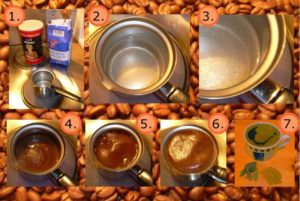
Author: Oliver Merkel, via Wikipedia Commons
Preparation of mocha coffee (Turkish Coffee). 1: Ground coffee, water, sugar, and heat source. 2, 3: heat the water till it starts bubbling. 4: add coffee. 5: continue heating and mixing. 6: heat until the mixture starts to rise, then take off the heat source to settle it down while mixing the upper part (repeated many times). This creates a foamy top. 7: pour and serve hot
Turkish culture distinguishes between four degrees of sweetness of the coffee, depending on the amount of sugar, şeker, that is added:
- sade (plain; i.e. no sugar added)
- az şekerli (little sugar; about half a level teaspoon of sugar)
- orta şekerli (medium sugar; about one level teaspoon)
- çok şekerli (a lot of sugar; 1.5 – 2 level teaspoons).
The coffee grounds left in the cup after finishing your fincan (cup) of Turkish coffee can be used for fortune-telling, called kahve falı or tasseomancy: the cup is turned over on the saucer to cool down and the patterns left by the coffee grounds, kahve telvesi, can then be interpreted to tell one’s fortune.
For more information:
https://en.wikipedia.org/wiki/Turkish_coffee
https://en.wikipedia.org/wiki/Cezve
Is there also a special beverage in your country or are there any special customs or superstitions associated with a beverage in your country? Tell us about it in the comments! 🙂
Vocabulary: ‘The weather’ in Celtic languages
Today’s blog post is continuing our series on the comparison of vocabulary of closely related languages and is taking us to the British Isles again, as well as to Brittany (Bretagne) in France, and to the various Celtic languages spoken there, namely Welsh, Irish and Scottish Gaelic, as well as Cornish and Breton. Our topic today is the weather and the most important words related to it. Both Welsh (Cymraeg) and Cornish (Kernewek) belong to the Brittonic group of the Celtic languages (to which also Breton Brezhoneg belongs), and Irish (Gaeilge) and Scottish Gaelic (Gàidhlig) belong to the Goidelic group (to which also Manx Gaelg belongs).
The terms for these weather-related words in Cornish/Kernewek:
weather – kewer, sunshine – Howl, wind – gwyns, rainbow – kammneves, rain – glaw, clouds – kommol, thunder – taran, thunderstorm – hagarawel derednow, lightning – lughes, snow – ergh, hail – keser
and in Breton/Brezhoneg:
the weather – an amzer, sunshine – Heol, wind – avel, rainbow – kanevedenn, rain – glav, cloud – koumoul, thunder – taran, thunderstorm – arnev, lightning – luc’hed, snow – erc’h, hail – grizilh

